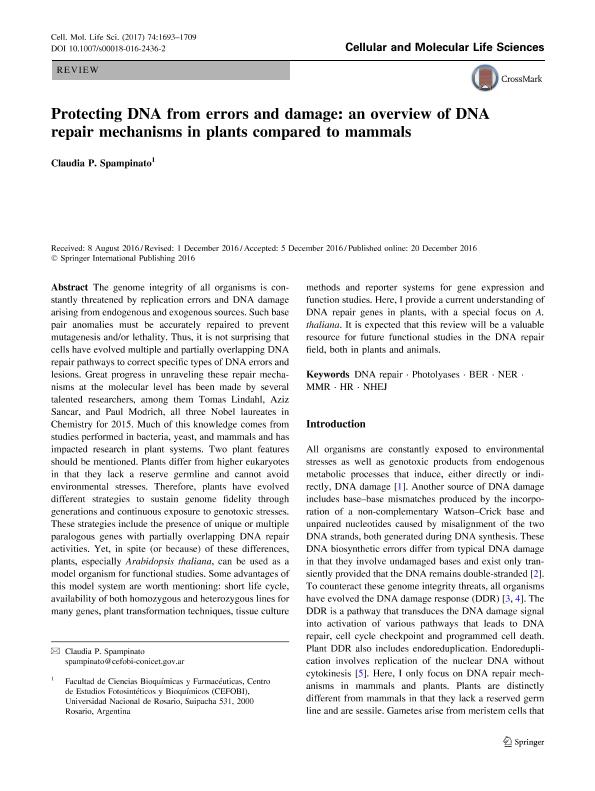Artículo
Protecting DNA from errors and damage: an overview of DNA repair mechanisms in plants compared to mammals
Fecha de publicación:
05/2017
Editorial:
Birkhauser Verlag Ag
Revista:
Cellular and Molecular Life Sciences
ISSN:
1420-682X
Idioma:
Inglés
Tipo de recurso:
Artículo publicado
Clasificación temática:
Resumen
The genome integrity of all organisms is constantly threatened by replication errors and DNA damage arising from endogenous and exogenous sources. Such base pair anomalies must be accurately repaired to prevent mutagenesis and/or lethality. Thus, it is not surprising that cells have evolved multiple and partially overlapping DNA repair pathways to correct specific types of DNA errors and lesions. Great progress in unraveling these repair mechanisms at the molecular level has been made by several talented researchers, among them Tomas Lindahl, Aziz Sancar, and Paul Modrich, all three Nobel laureates in Chemistry for 2015. Much of this knowledge comes from studies performed in bacteria, yeast, and mammals and has impacted research in plant systems. Two plant features should be mentioned. Plants differ from higher eukaryotes in that they lack a reserve germline and cannot avoid environmental stresses. Therefore, plants have evolved different strategies to sustain genome fidelity through generations and continuous exposure to genotoxic stresses. These strategies include the presence of unique or multiple paralogous genes with partially overlapping DNA repair activities. Yet, in spite (or because) of these differences, plants, especially Arabidopsis thaliana, can be used as a model organism for functional studies. Some advantages of this model system are worth mentioning: short life cycle, availability of both homozygous and heterozygous lines for many genes, plant transformation techniques, tissue culture methods and reporter systems for gene expression and function studies. Here, I provide a current understanding of DNA repair genes in plants, with a special focus on A. thaliana. It is expected that this review will be a valuable resource for future functional studies in the DNA repair field, both in plants and animals.
Palabras clave:
Ber
,
Dna Repair
,
Hr
,
Mmr
,
Ner
,
Nhej
,
Photolyases
Archivos asociados
Licencia
Identificadores
Colecciones
Articulos(CEFOBI)
Articulos de CENTRO DE EST.FOTOSINTETICOS Y BIOQUIMICOS (I)
Articulos de CENTRO DE EST.FOTOSINTETICOS Y BIOQUIMICOS (I)
Citación
Spampinato, Claudia Patricia; Protecting DNA from errors and damage: an overview of DNA repair mechanisms in plants compared to mammals; Birkhauser Verlag Ag; Cellular and Molecular Life Sciences; 74; 9; 5-2017; 1693-1709
Compartir
Altmétricas




